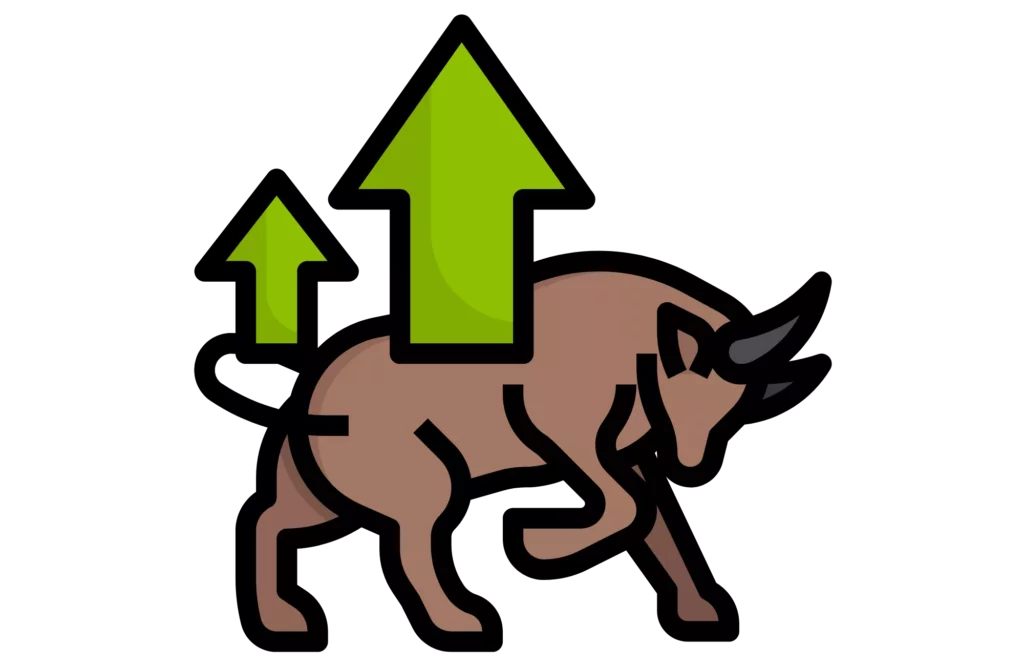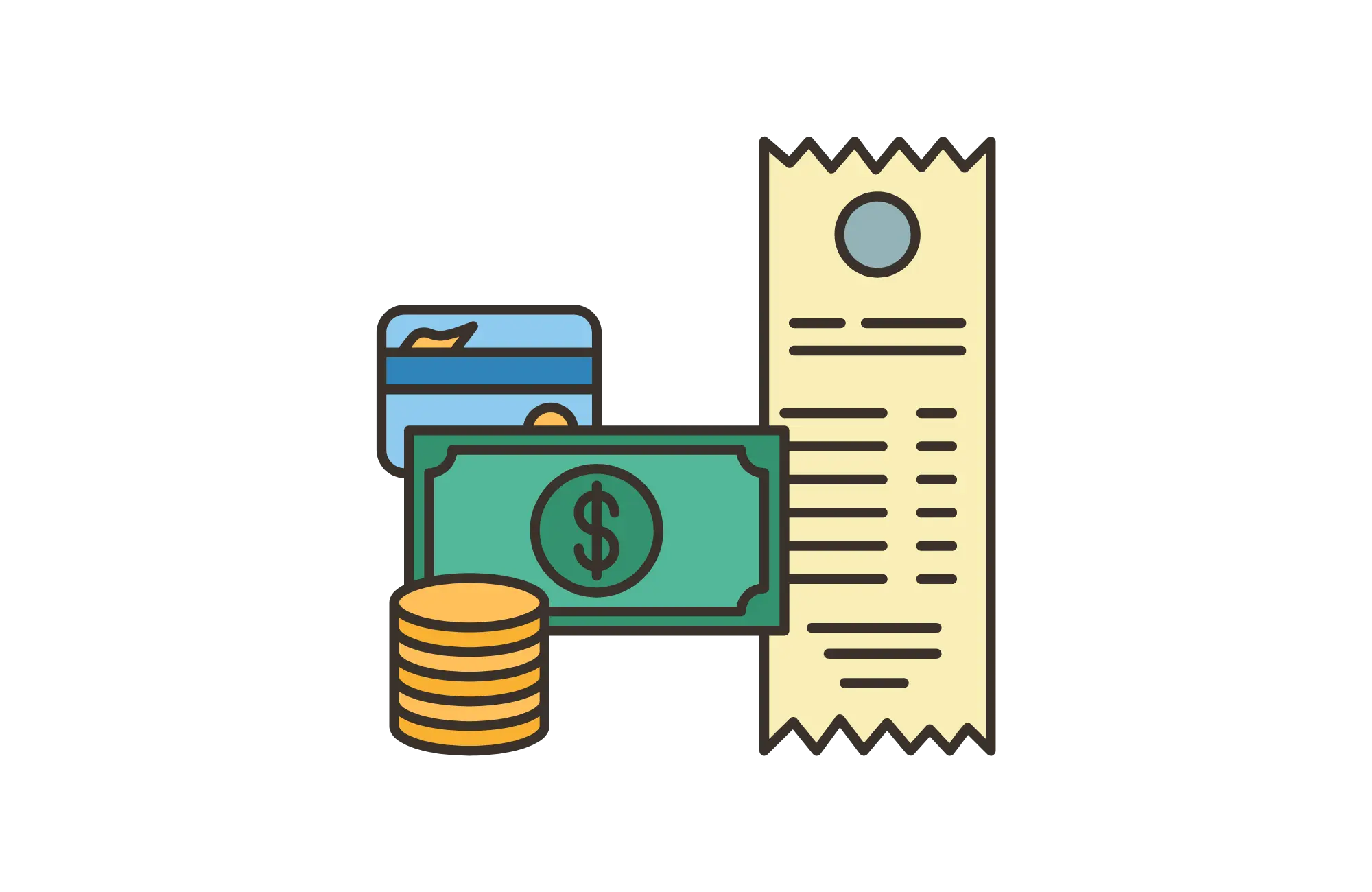
TABLE OF CONTENTS
It’s essential to understand the definition of investment terms like “bull market” if you plan to invest in the stock market or have investments through retirement funds. As a result of the volatility brought by COVID-19 and its impact on the world economy, financial news outlets have been discussing bull markets and bear markets.

So, what is a bull market? This guide explores markets, their characteristics, some examples of famous bullish markets, and other related topics. Let’s get started!
What Is a Bull Market?
Let’s define the term bull market in a bit more detail:
Bull market definition
A bull market describes an upward trend in stock market prices over a given period. People describe bull markets both in terms of years and months. A market is in its bull phase after a 20% increase over a given period and is typically preceded by at least a 20% decrease.
Bull market vs bear market
On the other hand, a bear market indicates a downward trend in stock market prices over months or years. In an opposite fashion to bullish markets, a market is in its bear phase after suffering a 20% decrease in prices, typically preceded by a 20% or more increase in prices.
Bullish stock meaning
If you read investment analysis, you may come across analysts that say they are “bullish” about a stock. This means that the analyst believes that the stock will perform well. If analysts believe that a specific stock price will decrease in the future, they say they are “bearish” about a stock.
Bull Market Characteristics
Below, let’s take a look at some characteristics that can exhibit a bull market:
Low-interest rates
One condition that can lead to a bull market is a low-interest-rate environment. Lower interest rates mean debt costs are affordable, making it easier for businesses to borrow money.
When central banks announce lower interest rates, this can increase company valuations, as investors assume the cost of debt will be lower for the foreseeable future. Yet, if interest rate decreases are more significant than the market expects, this can also lead to a reduction in stock prices.
Market stability
Market stability can increase consumer and investor confidence, which is a key element of a bull market. If stakeholders in a market feel confident that the conditions will remain predictable in the near future, they are more likely to invest.
Low unemployment figures, GDP growth, and other factors can stabilize a market. Events such as elections, natural disasters, policy changes, and increases in unemployment can lead to market instability.
Business profitability
There’s no doubt that good financial returns play a role in bull markets. If businesses are returning solid profit margins, this can increase stock prices. As companies increase profits, they can invest in future growth and issue dividends to their shareholders. Keep in mind, some bull markets can lead to frenzies, which result in bubbles that exceed earnings.
Investor confidence
Investor confidence is one of the most notable characteristics of a bull market. Investors who are confident in the market are more likely to invest their capital. As capital floods into the stock market, it increases trading that can improve stock prices.
Likewise, when investor confidence is high, it’s easier for companies to raise money. This allows companies to invest more money into growth and production. Low-interest rates, strong profitability, clear regulation, and other factors can all improve investor confidence.
International investors
Globalization resulted in an increase in trade across the world and has made international investment more prevalent.
If a particular economy or stock market is performing well, it is likely to attract the attention of foreign investors. These investors can provide capital injections that improve prices in a stock market. Markets that are attractive to foreign investors – due to strong legal frameworks, reliable market conditions, and other factors – benefit from capital inflows.
Bullish Indicators to Identify a Bull Market
If you want to identify a bull market, keep your eyes peeled for the following bullish indicators:
Top-line growth
When you hear investors refer to “top-line growth,” they are speaking about an increase in a business’s top-line revenue, which is the overall revenue or turnover for the company. Bull markets will often see businesses increase their overall revenue.

As an economy’s top-line growth typically coincides with GDP increases, it can point toward an economy with healthy demand. This can improve investor confidence and create conditions for good economic performance.
Bottom-line growth
However, top-line growth alone does not necessarily indicate a strong economy. If businesses are only achieving top-line growth because they are overspending to achieve sales, this can be bad for stock prices. For this reason, “bottom-line growth” – or growth in profits – is also essential to explore.
Price-to-earnings ratio (P/E)
A stock’s price-to-earnings ratio (P/E) is the stock’s price divided by the same company’s earnings per share. This is one of the indicators that investors use to determine if they want to invest in the market.
For example, if a business earns $1 billion per year and has 1 billion shares, its earnings per share are $1. If the same business’s stock price is $10, then you divide the $10 stock price by 1 (the EPS) for a P/E ratio of 10.
A P/E ratio can help investors decide if a company is overvalued. While acceptable P/E ratios depend on industries and other factors, this is always worth considering if you are investing in bull markets.
Bull Market Examples
Bull markets can create exciting case studies. Below, let’s provide some context to the term bull cycle by exploring four prominent examples in modern history:

1. Post-war boom: 86 months
One of the most striking examples of a bull market is the post-war boom that the United States experienced after WWII. While there’s no doubt that the war created untold losses for many American families, the need for advanced technology and machinery and many other factors created strong economic conditions once the war was over.
The United States had used its manufacturing strength to win the war, and this ability to be productive yielded solid results for both export and domestic markets. While the government no longer needed the same number of weapons, the factories used to supply the military could now be reconverted into hubs for producing consumer goods.
As technology made its way into US homes and factories, the domestic economy benefited from an efficiency boom that helped market conditions. The S&P 500 saw an increase of more than 260% in this time period. Unfortunately, the potential for inflation began to enter the economy in 1956, which caused the Federal Reserve to increase interest rates. This resulted in a reduction in stock market prices that ended the bull run.

2. Ronald Reagan’s tax cut boom: 60 months
In the early 1980s, Ronald Reagan inherited an economy that was in deep turmoil. With high unemployment and inflation at around 10%, American families were struggling financially. The Federal Reserve had pushed higher interest rates to combat inflation, which had consequences for the business landscape. It was in these circumstances that Reagan made his famous tax cuts. At the time, the top federal tax rate was 70% and Reagan reduced this to 50%.
While there is little doubt that Reagan’s tax cuts worked to boost the economy and create the bull run, other factors are also relevant. At the same time as the tax cuts, Reagen increased federal spending on infrastructure and defense. The Federal Reserve also lowered rates, and this provided much-needed stimulus to the economy.
However, toward the end of the 80s, economic conditions worsened again. In October of 1987, the stock market crashed, resulting in more than 20% of losses in the Dow Jones in a single day.

3. Age of the internet: 113 months
In 1990, a bull run began due to favorable corporate earnings results and the introduction of various tech companies. Toward the end of the decade, the bull market turned into a frenzy. Tech companies began to receive outlandish valuations, driving huge returns in the stock market for initial investors.
An IPO-mania began, which saw further growth in the tech sector. New founders became multi-millionaires by listing their companies on the stock exchange, and the same rang true for tech companies with more established profiles.
In fact, from 1995 to 2000 alone, NASDAQ company stock prices grew more than 400%. However, while the bull run ended in 2000, the full crash did not occur until 2002. When the bubble burst, it wiped out many tech companies that previously had strong valuations.

4. Longest bull market in history: 131 months
The longest bull market in modern American history is much more recent than you may think. It extended from March 2009 to March 2020.
The years preceding this bull run witnessed the subprime mortgage crisis that resulted in economic loss and turmoil throughout the world. The pain caused by the economic crisis resulted in extremely low-interest rates and other favorable economic conditions. The access to cheap capital allowed businesses to invest and corporate earnings improved. Over the 131 months included in this bull run, the S&P 500 grew more than 400%.
Unfortunately, as with all previous bull markets, this positive trend came to an end. At the start of 2020, when COVID-19 sent markets downward and shut the world’s economy, this bull run was finally over. This is an example of how outside forces can wreak havoc on economies, even if previous economic conditions appear positive.
How to Invest in a Bull Market
Unfortunately, it’s almost impossible to beat the market as a retail investor. For this reason, employing different strategies for bull trading and bear trading is not advisable for non-professional investors. As markets can be impossible to predict, there’s no fool-proof method for investing in bull markets. In fact, up to 80% of active fund managers are not beating the current market indexes – and these are professionals.
Investing in the overall market over a long period of time, without liquidating during various market cycles, is often thought to be the best approach to retail investing.
What Does Bull Market Mean? Final Thoughts
Now when you hear the term “bull stocks,” “bull stock market,” or “bull run,” you understand that it means stock market prices are rising and interest rates are falling. If you’re a business owner who finds yourself in a bull market, take advantage of business funding loans with affordable rates.
Bull Market FAQs
If you find bull markets interesting, you may have more questions. Check out the common questions and answers in more detail below:
How long do bull markets last?
There is no definitive answer to this question, as bull markets differ from one another in longevity, causation, and other elements. Markets are ever-evolving, which means that many events can quickly change investor confidence, interest rates, and other characteristics that may impact bull or bear markets.
However, research from 2019 suggests that the average bull market since 1932 has lasted around 3.8 years.
What is a bull run?
A bull run is another term for a bull market. It refers to an upward trend in stock market prices, typically over a period of months or years. These terms are interchangeable.
Why is it called a bull market?
While the precise origin of the term bull market is hard to identify, the meaning may lie in the animal’s method of attack. As bulls attack with their horns upward, a “bull” market refers to uptrends. On the other hand, as bears attack downward with their paws, is the reason a “bear” market refers to downtrends.
What is the opposite of a bull market?
The opposite of a bull market is a bear market. A bear market is a market that trends downward over a given period.
When is the best time to buy in a bull market?
Theoretically speaking, the best time to buy in a bull market is at the start of the bull run. This approach will see the most return for your money if you sell your shares at the top of the market. However, knowing that a bull run is starting is next to impossible and picking the perfect time to sell your shares is also extremely difficult.
What is a secular bull market?
A secular bull market refers to a long-term bull market in which market prices rise more than they fall over the given period. There may be cyclical bear markets during a secular bull market, but the long-term trend will remain positive. Occasionally, a recession may even occur during a secular bull market.
What causes prices to rise in a bull market?
The cause behind prices rising in a bull market depends on the individual bull run. In many cases, a bull run is the result of low-interest rates, investor confidence, business-friendly regulatory environments, market stability, and a host of other conditions.







